| Opiliones
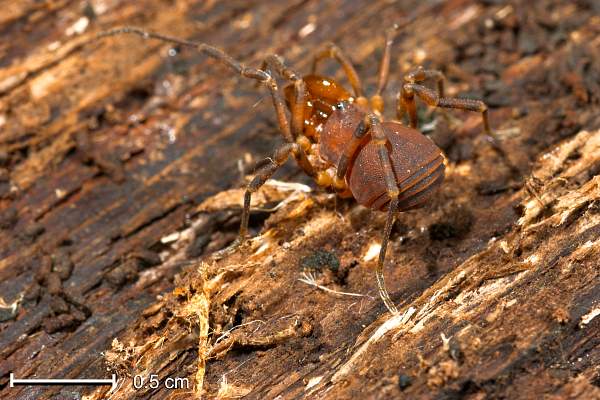
Harvestman (Laniatores: Nuncia sp.), New Zealand, South Island.
Common name: harvestmen, daddy-long-legs
Scientific name: phylum Arthropoda, class Arachnida, order Opiliones. From Latin "Opilio", shepherd.
Description
Harvestmen (order Opiliones) are members of the class Arachnida, together with spiders, scorpions, pseudoscorpions, ticks and mites. Like all arachnids, harvestmen have four pairs of walking legs, a pair of chelicerae, and a pair of small, leg-like appendages called pedipalps.
The body of a harvestman is globular and rounded, and is formed by the fusion of two parts, the cephalothorax and the abdomen. A small shield - carapace - covers the front part of the body, and several narrow segments are evident in the abdominal area. The fused body and abdominal segmentation distinguish harvestmen from closely related groups - spiders (Araneae) and mites (Acari). The body of spiders is never fused together into a single globule - instead, spiders have well-separated cephalothorax and abdomen. The globular body of mites is never obviously segmented.
The body of most species is only 3-7 mm long, but the animals often appear larger due to their long legs (in one group of harvestmen the legs are exceptionally long - up to 20 times the length of the body). The second pair of legs is often the longest, having a tactile sensory function. Two simple eyes usually sit close together on top of a small tubercle in the middle of the carapace. In some primitive mite-like harvestmen the eyes are absent.
The colour of harvestmen is usually cryptic - dull shades of brown and black, although some have brighter coloration with patches of orange, white, and green. Some species show sexual dimorphism, with males and females differing in colour and body shape. Because they look so different, males and females of some native New Zealand harvestmen were initially described as separate species.
The order Opiliones includes three sub-orders, all of which have representatives in the New Zealand fauna:
Cyphophthalmi - the mite-like harvestmen - are small (2-3 mm), slow-moving primitive harvestmen which resemble dark, hard-bodied mites. About thirty species live in the soil and leaf litter of New Zealand forests. All of the New Zealand species are blind.
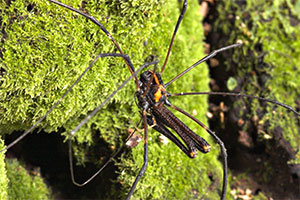
Native long-legged harvestman (Palpatores: Megalopsalis sp.), male. New Zealand, North Island.
Palpatores, the long-legged harvestmen, also known as "daddy-long-legs", so-called because of their extremely long legs between which the small oval body is suspended. The second pair of legs is the longest and is used as a tactile organ. The leg span of a large native male can reach 16 cm, while his body is only 6-7 mm in length. Sometimes a leg or two are missing, and the legs are cast off easily if the animal is handled. The pedipalps are small and slender. The males of the native Palpatores are velvety black, sometimes with patches of orange and white, and have greatly enlarged, very long 2-segmented chelicerae, while the chelicerae of brownish females are quite small.
Examples of Palpatores are the native species of Megalopsalis and Pantopsalis, and the common European species Phalangium opilio, which has established in New Zealand. The long-legged harvestmen may be confused with another group known as the "daddy-long-legs" - the cellar spiders (Pholcidae), which are light-brown spiders with very long legs and small body, common in New Zealand houses.
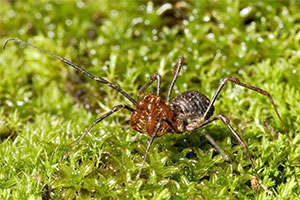 Soerensenella
Soerensenella sp. - one of the many species of native Laniatores. New Zealand, North Island.
Laniatores, or short-legged harvestmen, are the most diverse group of harvestmen in New Zealand. About 160 native species have been described, with many more probably still unknown. The Laniatores can be larger in size than the previous group, but the legs are much shorter - no more than 5 times the length of the body. The pedipalps of short-legged harvestmen are enlarged, thick, and heavily armed with spines. They are thought to act as grasping appendages similar to those of a praying mantis. The hardened body cuticle often carries an abundant ornamentation of spines, tubercles, and projections. The pattern of body ornamentation and the morphology of mating organs are used in species identification.
Notes on biology
The feeding habits of harvestmen are quite diverse, and not known for many species. Some species are predominantly predators, feeding on small invertebrates, while other species are omnivorous, and may consume dead plant and animal matter as well as small live invertebrates and fungi.
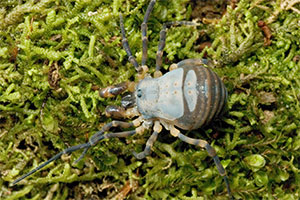
Moulting New Zealand harvestman: the body colours appear dull, and the pattern is indistinct.
Sexes are separate, and in many species there is a considerable degree of sexual dimorphism (males and females differ in colour, size, and body shape). Courtship and mating behaviour are variable, but insemination is direct. Parthenogenesis is known to occur in some species. Small eggs are deposited in groups in moist, well protected places - for example under the bark of rotting logs. In some species the female stays with the eggs. The young harvestmen resemble adults and grow through a series of moults. Adult harvestmen continue to moult regularly. The life span can vary from one to several years, but it is not known for many species.
Harvestmen are preyed upon by birds and small mammals. Everyone who handles live harvestmen will notice the lasting stinking odour they leave on one's fingers. This stinky secretion, which is thought to provide defence against predators, is produced by a pair of glands and is released from two openings on the harvestman's body. Apart from the unpleasant smell, harvestmen are harmless - they do not possess poison glands and do not bite. Another interesting defence mechanism can be seen in the introduced harvestman Phalangium opilio - if it is mishandled, it will cast off one or two of its legs, which continue to twitch for several minutes, distracting the predator while the harvestman escapes.
Where to find them?
Harvestmen lead a cryptic life. The long-legged harvestmen are surface dwellers. They are mainly active during the night, when the native forest species can be observed in the open on the surface of trees and on the forest floor. The short-legged Laniatores are common among damp leaf-litter, under the loose bark of rotting logs on the ground, in moss, and in similar habitats. Many species of harvestmen are cave dwellers.
All but the smallest mite-like harvestmen are easily collected by hand, although this occasionally causes damage to the specimen. Other methods for collecting, especially useful for small or hard-to-find forms, are pitfall traps and Berlese-Tullgren funnels. Collected harvestmen can be preserved in 75% alcohol.
Distribution and conservation
Worldwide, about 3500 species of harvestmen are known. The short-legged Laniatores have predominantly southern hemisphere distribution, with the highest diversity found in Australasia, South America, and Africa. To date, more than 160 Laniatores species are described in the NZ fauna. Among New Zealand Laniatores, the family Synthetonychidae (14 species) is endemic to NZ. The remaining 140+ species belong to the family Triaenonychidae, with related species found in Australia, South Africa, and Chile. Unlike Laniatores, the long-legged harvestmen (Palpatores) are most diverse in the northern hemisphere (temperate regions of North America, Europe, and Asia), although some species occur in the tropics. About a dozen native New Zealand Palpatores are placed into two genera - Megalopsalis and Pantopsalis. The mite-like harvestmen (suborder Cyphophthalmi) occur worldwide, but
one family has a definite Gondwanan distribution, with species in South America, Africa, Australia, and New Zealand. New Zealand represents a biodiversity hotspot for Cyphophthalmi, as NZ species make up a quarter of the suborder. Of the many Opiliones species living in New Zealand, only a part are discovered and named, and little is known of their biology or environmental role.
|
Native species of harvestmen are found in forests and grasslands from sea level to the alpine zone. The native harvestmen of New Zealand may be threatened by habitat destruction and by invasion of introduced predators. Currently, harvestmen receive no protection from the New Zealand Department of Conservation, although their high endemism is acknowledged. The ability of native species to invade modified habitats is still unknown.
The long-legged harvestman common in gardens, parks, and along roadsides is the introduced European Phalangium opilio. This harvestman is active during the daytime, and is the one most often seen in urban habitats. It has nearly worldwide distribution. |
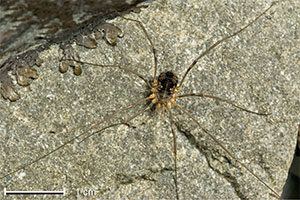
Introduced Phalangium opilio, roadside, South Island, NZ.
|
Included images:
- Family Monoscutidae
- Megalosalis sp. - Katikara Stream, Taranaki, TK, North Island (4 images)
- Family Triaenonychidae
- Soerensenella ?prehensor - Ohinetonga Scenic Reserve, TO, North Island (3 images)
- Nunica sp. - Palmerston North, WI, North Island
- Nunica sp. - Westland National Park near Okarito, WD, South Island (2 images)
- Nunica sp. - Hinewai Reserve, Banks Penninsula, MC, South Island (2 images)
- Nunica sp. - Hinewai Reserve, Banks Penninsula, MC, South Island (2 images)
- Family Phalangiidae
- Phalangium sp.* - Torlesse Range, Porters Pass, NC, South Island
- Other
- Unidentified species - Karewarewa Scenic Reserve, RI, North Island
- Unidentified species - Karori wildlife sanctuary, WN, North Island
- Unidentified species - Palmerston North, WI, North Island
- Unidentified species - Craigieburn Forest Park, Cave Stream, NC, South Island
- Unidentified species - Craigieburn Forest Park, Cave Stream, NC, South Island (2 images)
- Unidentified species - Craigieburn Forest Park, Cave Stream, NC, South Island (2 images)
- Unidentified species - Hinewai Reserve, Banks Penninsula, MC, South Island (4 images)
- Unidentified species - Peel Forest Park, Dennistoun Bush, SC, South Island
- * - species exotic in NZ
Further information on New Zealand harvestmen:
Boyer, S.L., Giribet, G. 2003. A new Rakaia species (Opiliones, Cyphophthalmi, Pettalidae) from Otago, New Zealand. Zootaxa 133: 1-14.
Boyer, S.L., Giribet, G. 2004. Systematics and biogeography of New Zealand harvestmen of the family Pettalidae (Arachnida, Opiliones, Cyphophthalmi). Cladistics-the International Journal of the Willi Hennig Society 20 (1): 78-78.
Forster R.R. 1943. The genus Adaeum Karsch (=Algidia Hogg) in New Zealand, with descriptions of new species (Order Opiliones). Transactions of the Royal Society of New Zealand 73 (1): 68-72.
Forster R.R. 1944. The genus Megalopsalis Roewer in New Zealand, with keys to the New Zealand genera of Opiliones. Records of the Dominion Museum 1: 183-192.
Forster R.R. 1948. The suborder Cyphophthalmi in New Zealand. Dominion Museum Records in Entomology 1 (7): 79-119.
Forster R.R. 1948. A new genus and species of the family Acropsopilionidae (Opiliones) from New Zealand . Transactions of the Royal Society of New Zealand 77 (1): 139-141.
Forster R.R. 1948. A new sub-family and species of New Zealand Opiliones. Records of the Auckland Institute and Museum 3 (4): 313-318.
Forster R.R. 1949. The zoogeographical relationships of the New Zealand Opiliones. Transactions of the Royal Society of New Zealand 77 (5): 233-235.
Forster R.R. 1952. Supplement to the sub-order Cyphophthalmi. Dominion Museum Records in Entomology 1 (9): 179-211.
Forster R.R. 1954. The New Zealand Harvestmen (Suborder Laniatores). Canterbury Museum Bulletin 2: 1-329.
Forster R.R. 1962. A key to the New Zealand harvestmen. Part 1. Tuatara 10 (3): 129-137.
Forster R.R. 1963. A key to the New Zealand harvestmen. Part 2. Tuatara 11 (1): 28-40.
Forster R.R. 1964. The Araneae and Opiliones of the subantarctic islands of New Zealand. Pacific Insects Monographs 7: 58-115.
Forster R.R. 1965. Harvestmen of the sub-order Laniatores from New Zealand caves. Records of the Otago Museum 2: 1-18.
Forster R.R. 1974. Harvestmen. New Zealand's Nature Heritage 4 (49): 1374-1376.
Forster R.R, Forster LM. 1999. Spiders of New Zealand and their Worldwide Kin. University of Otago Press, Dunedin. 270pp.
Gruber, J., and G.S. Hunt. 1973. Nelima doriae (Canestrini), a south European harvestman in Australia and New Zealand (Arachnida, Opiliones, Phalangiidae). Records of the Australian Museum 28(16): 383-392
Hogg H.R. 1909. Spiders and Opiliones from the Subantarctic Islands of New Zealand. In: The Subantarctic Islands of New Zealand. Vol.1, Wellington, pp. 155-181.
Hogg H.R. 1910. Some New Zealand and Tasmanian Arachnidae. Transactions of the New Zealand Institute 42: 273-283.
Meyer-Rochow, V.B. Liddle, A.R. 1988. Structure and function of the eyes of two species of opilionid from New Zealand glow-worm caves (Megalopsalis tumida: Palpatores, and Hendea myersi cavernicola: Laniatores). Proceedings of the Royal Society of London: Series B: Biological sciences 233, p. 293-319.
Taylor, C.K . 2004. New Zealand harvestmen of the subfamily Megalopsalidinae (Opiliones: Monoscutidae) - the genus Pantopsalis. Tuhinga: Records of the Museum of New Zealand Te Papa Tongarewa 15.
Vink, C.J., Teulon, D.A.J., McLachlan, A.R.G., Stufkens, M.A.W. 2004. Spiders (Araneae) and harvestmen (Opiliones) in arable crops and grasses in Canterbury, New Zealand. New Zealand Journal of Zoology 31 (2): 149-159.
Watt, J.C. 1983. Hexapoda, myriapoda and arachnida. In: Brownsey, P.J., Baker, A.N. (Eds). The New Zealand Biota. What Do We Know After 200 Years. National Museum of New Zealand, Miscellaneous Series Number 7.
Opiliones Resources on the Web:
Order Opiliones, Izico Museums of Capetown. Brief background, habitat and physiology
Harvestman, by Luc Vanhercke, Ed Nieuwenhuys. Brief background and very good images of European species.
Answers to common questions about harvestmen, The Opiliones Internet Discussion Group hosted by the Arachnology Homepage. Includes information on feeding, habitat, types, sociality, conservation.
Harvestmen (Daddy long-legs), by Jim Conrad, Backyardnature.net. Includes picture and basic information.
Opiliones or Phalangida - what's in a name? by D. J. Curtis, Ariadne (personal website). Classification of harvestmen - Cyphophthalmi, Laniatores, Palpatores, and the link to Opiliones Notes.
Cave Spider, from Arthur's Pass webscape information. Info on a possibly endangered NZ harvestman species, with photo.
Australian Faunal Directory: References for group 'OPILIONES', bibliography for Australian fauna.
Opiliones, by Adriano B. Kury. Well-illustrated taxonomy of harvestmen, with the link to Opiliones bibliography.
|